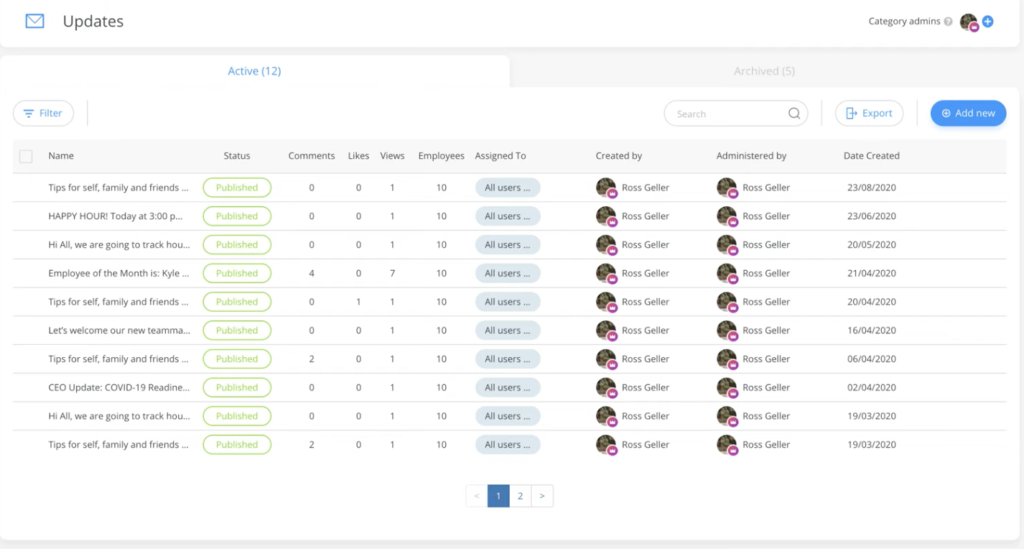Understanding how to measure the success of your internal communication strategy is key to making your company’s operation easier, more effective, and more enjoyable.
An effective internal communication strategy is essential to any successful business. The oft-unsung heroes of internal comms help keep information flowing smoothly. But if you’re one of this small band of hardworking communicators, you probably have dozens, even hundreds of employees to support. Different departments and employees have different processes, objectives, and personalities. It can be hard to measure success with a dispersed workforce.
The good news is, with the right data, you can accurately assess and improve upon your internal comms strategy. Doing so can dramatically improve employee engagement and make your job much easier.
Connecteam offers a variety of ways for internal communicators to measure the impact and effectiveness of their communications strategy—and more than a few ways to adjust that strategy accordingly.
Keep reading to learn more about which metrics will give you the clearest picture of your internal communication strategy and what you can do to improve it.
Why setting and tracking objectives matters for internal communications
Settings and tracking objectives is important for a few reasons.
First, it helps teams to align on important company goals, including those which require cooperation between different departments. Recently, more and more companies have come to realize that greater communication and collaboration between departments (what’s sometimes called being “non-siloed”) leads to greater agility, efficiency, and stability. Setting common, meaningful goals brings clarity of purpose and encourages camaraderie.
Second, it allows companies to become truly data-driven, meaning that key decisions are made based on data and evidence, rather than best guesses. By setting objectives and measuring your performance, you have a much clearer picture of your strengths and weaknesses — where you excel and where you need to improve. This helps ensure business processes continue to improve and meet the demands of company growth.
Finally, having clear objectives will help you prioritize your work more effectively and focus on the things that really matter. Not only does this improve productivity, it also helps reduce burn-out and makes for a more enjoyable working environment. The structure offered by setting and tracking objectives helps small comms teams have a greater impact.
Measure, Compare, Adjust
If you aren’t sure where to start to determine if your internal communication strategy is effective, try some simple frameworks to generate helpful data and assess your goals.
Measure, Compare, Adjust is an essential technique. This straightforward method helps turn day-to-day actions into data and data into actionable insights. The concept is simple: One, measure key metrics; two, compare them to your objectives; and three, adjust your strategy accordingly.
Both metrics and objectives can be described using Key Performance Indicators, or KPIs. These are quantifiable measures of progress in regard to some specific business objective.
For example, one popular metric for internal communication teams is the open rate for messages such as emails (discussed below). A useful business objective might be: “Increase the open rate of communications by 10% over the next three months.”
Another useful framework is SMART goals. SMART stands for Specific, Measurable, Attainable, Relevant, and Time-bound. From our example:
- Specific: Increase open rate
- Measurable: by 10%
- Attainable: 10% is a reasonable goal for the time period
- Relevant: The open rate is known to reflect engagement
- Time-bound: Three months
Download your FREE guide on “10 Tips for Engaging Your Frontline Teams” ⤵

Below, you’ll find five key metrics and objectives that you can measure and test using these two methods to learn if your internal communication strategy is working.
Metric 1: Reach
Reach refers to the number of people your message has the potential to be read by or impact.
With Connecteam, for example, you can measure reach using the number of registered users or the overall login rate.
The first tells you how many people are using the platform. If it’s not 100%, you’ll want to set yourself a KPI for reaching that target as soon as possible.
The second lets you know how many people are actively using the app at any given time. Active users are more likely to receive messages in a timely fashion. Again, you’ll want this number to be as high as possible, or little else you do downstream will have the impact it otherwise could.
One effective way to address low reach is to speak with department heads and other team leaders and ask them to address the issue internally. Explain the benefits for them and their team, like ensuring everybody is up-to-date on company-wide policies, announcements, and all the useful features the platform offers. Connecteam, for example, offers people management tools for employee recognition, mobile-first training, documentation, rewards, quizzes, and team milestones.
Metric 2: Views
Views refers to the number of people who actually saw a message.
Views are typically lower than reach, as not everybody who can receive a message actually does (if they don’t log in regularly, for example). Furthermore, not everybody who receives a message actually opens and reads it.
Legacy systems like email offer rudimentary metrics for views, like email open rate. These can provide useful insights, but a full-featured communications platform will let you take this much further for a better understanding of why certain individuals or groups may not be seeing important updates.
For example, Connecteam’s Updates dashboard (shown below) provides an overview of updates and messages sent to different teams with several metrics, including the number of views. You can also drill down into the specifics and see who exactly viewed your message when.

There are several ways to improve views, including reminders. A targeted approach to publishing updates can also increase views. This feature allows you to send different updates to different groups and individuals at different times. It helps cut through the noise that plagues many internal team communications platforms, so employees know that when they receive a message, it’s important and worth their time.
With Connecteam, you can also set specific times for messages and reminders. This is particularly helpful when communicating with deskless teams that may be busy or wholly incommunicado at certain times of the day.
Metric 3: Engagement
Engagement refers to the number of people who interact with an update.
There are a few ways to measure this, and every company is a bit different. With Connecteam, you can easily measure engagement through simple reactions to updates such as likes and comments, but you can also provide the opportunity for more sophisticated, meaningful engagement with surveys, live polls, checklists, and more.
Engagement is one of the most important metrics to measure, as it directly reflects employees’ interest and attention. There are a few simple ways to address low engagement.
Mentioned above, targeted updates are particularly effective. They allow you to adjust the timing and even content of updates for different audiences, This helps ensure the updates employees see are relevant to them. Targeted updates can help boost engagement significantly: people respond better to messages they feel are written specifically for them.
This also reduces the number of updates employees see. According to one survey, one in three employees say they receive too many emails to keep up. This leads to important updates being missed and is a major contributor to burnout. Deskless teams in particular rely on written updates to stay informed, so getting this right is a must.
Ensuring employees can engage with content in a familiar way is also helpful. By definition, deskless teams tend to rely more on mobile devices like smartphones than desktop computers, so a mobile-first experience is key. Connecteam’s social media-style feed helps take this a step further, with quick and simple ways to react or offer an opinion.
Metric 4: Satisfaction
Employees’ satisfaction with your internal communication platform can have a huge impact on other metrics, including reach, views, and engagement. An internal communication system that’s clunky or difficult to use, especially on mobile devices, is sure to cause headaches.
Having to use multiple platforms also tends to erode employee satisfaction. Gone are the days where there must be a separate solution for updates, person-to-person messages, file sharing, scheduling, timeclock, training—well, you get the idea. Simplicity is king.
We’ll proudly toot our own horn on this one: one of the reasons organizations find Connecteam so effective is because employees enjoy using it and knowing everything is in one place.
With the right tool, measuring satisfaction regarding your internal communications strategy is simple. Surveys are a highly effective way of doing this and allow you to drill down into specific pain points while gathering data on metrics for communications and every other department to compare to KPIs. They’re also a core feature of Connecteam. Anonymous surveys are especially effective at measuring satisfaction.
Of course, surveys and polls aren’t just for assessing your communications strategy—they’re an important part of that strategy itself! Once you understand your workforce better, you can use that data to make changes and innovate.
Metric 5: Turnover rate
It would be unfair to lay a high turnover rate solely at the feet of internal communication. A variety of factors play into most employees’ decision to leave a company. However, poor communications is a significant one and cannot be ignored when it comes to turnover rate.
It’s simple to measure turnover rates and compare them to a relevant KPI, but adjustments are more difficult. Nonetheless, there are relatively simple, and yet highly effective changes that can be made just where communications are concerned.
First, a simple, intuitive, mobile-first communications app is a must. This has been shown to dramatically improve the reach and impact of internal communication and improve overall employee engagement with companies, which has widespread implications for turnover rates.
Providing a platform for employees to offer their opinions, discuss important issues, and simply have a voice is also an important step toward improving employee satisfaction and reducing turnover. With Connecteam, this is reflected in likes, comments, surveys, polls, and more.
Finally, a good internal communication platform allows internal comms and leaders at all levels to provide support to front-line teams, responding to needs and requests in real-time and gauging and acting on feedback.
Conclusion
Understanding the effectiveness of your internal communication strategy is essential, and the first step is measuring your metrics. Having actionable insights to improve and simplify your operations can make your job easier, more effective, and more enjoyable.
Connecteam offers an all-in-one solution to communications, with everything businesses need to effectively communicate with employees—not just sending out updates, but receiving invaluable feedback, opinions, and engagement. By tying together daily operations, communications, and tools and support for employees, Connecteam offers a one-stop shop for effective, effortless communications and business management. Book a demo to see how we can help your business.


